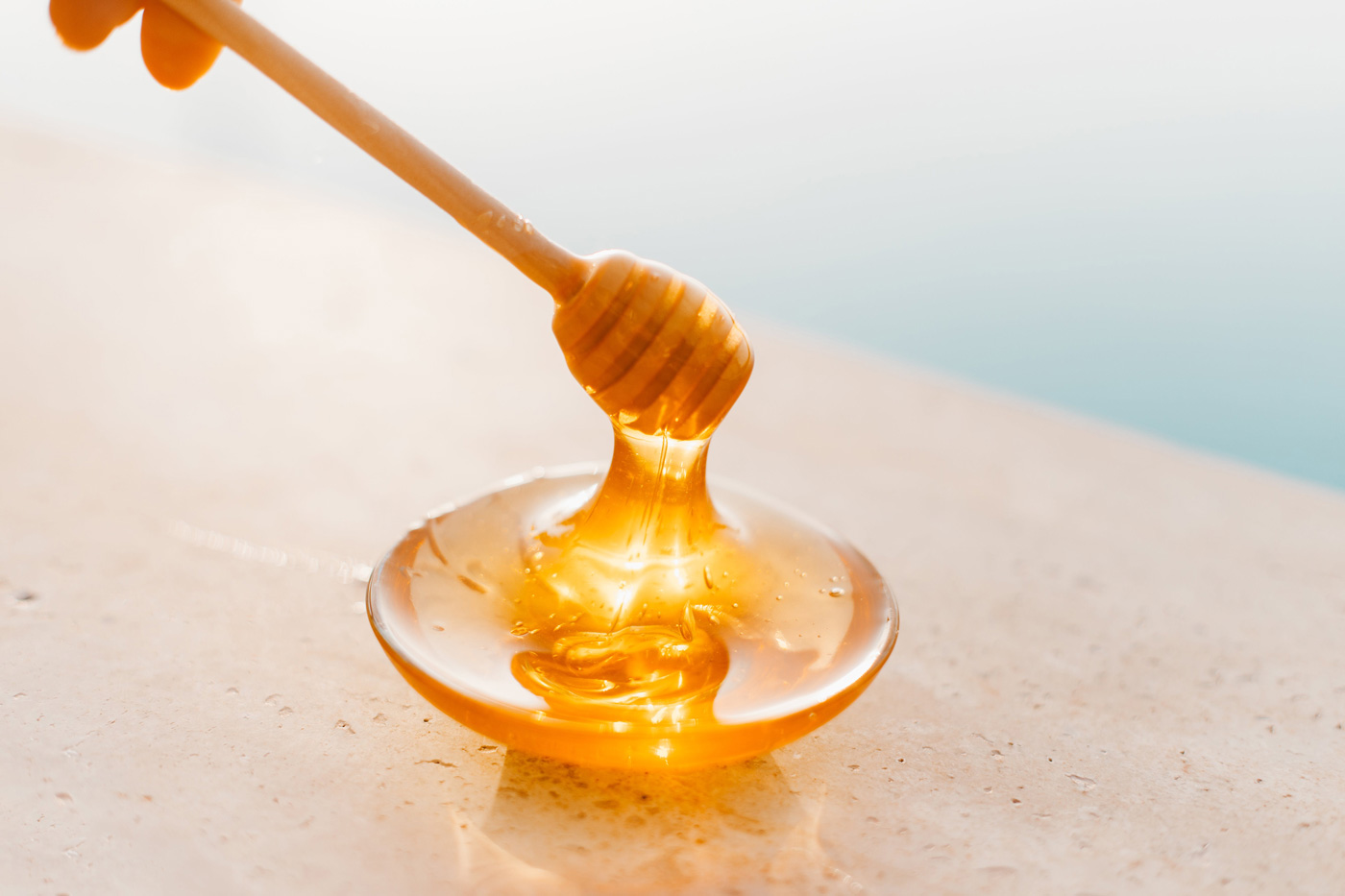
Photo by ROMAN ODINTSOV: https://www.pexels.com/de-de/foto/teller-loffel-suss-honig-6422025/
Is honey anti-inflammatory? Today we would like to take a closer look at this question. Honey, that golden, sweet nectar of bees, is not only a treat for the palate, but has also been prized for centuries for its potential health benefits. Let’s take a closer look at the scientific evidence.
The composition of honey: a natural treasure trove of nutrients
Honey is a natural product that is collected and processed by honeybees from the nectar of flowers. The exact composition of honey can vary depending on the type of flower, geographical location and other environmental factors. However, here are the basic ingredients of honey:
- Water: Honey consists largely of water, usually around 17-20%. The exact proportion of water can vary depending on the variety and ripening time of the honey.
- Sugar: The main types of sugar in honey are glucose and fructose. These two sugars make up the majority of the carbohydrates in honey and are responsible for its sweet taste.
- Enzymes: Honey contains various enzymes that are added by the bees during the collection and processing process. These enzymes play a role in converting the nectar into honey and influence its chemical composition.
- Aromatic substances: The aromatic substances in honey come from the essential oils of the flowers that the bees have visited. This gives each honey a characteristic flavor and fragrance.
- Minerals: Honey contains trace elements such as iron, zinc, calcium, potassium, phosphorus and magnesium. The quantities vary depending on the plants visited by the bees.
- Vitamins: Although honey does not contain significant amounts of vitamins, traces of vitamins such as B vitamins may be present.
- Antioxidants: Honey contains various antioxidants that can help neutralize free radicals and reduce cell damage. These antioxidant properties may depend on the type of flower and other factors.
- Pollen: Small amounts of pollen can be present in honey and can provide regional information about the plants that were pollinated by the bees.
- Methylglyoxal (MGO): A special ingredient found in higher concentrations in Manuka honey, known for its antibacterial properties.
It is important to note that the quality and health properties of honey depend greatly on its purity and origin. Raw, unprocessed honey usually retains more of its natural nutrients and bioactive compounds than industrially processed honey.
https://www.wanuka.de/aktuelle-laborberichte/
Antioxidant effect: a protective shield against inflammation?
The antioxidants in honey can help neutralize free radicals in the body. Free radicals are molecules that can cause oxidative stress, which in turn can lead to inflammation. By reducing oxidative stress, honey could therefore have an indirect anti-inflammatory effect.
Phenolic compounds in honey
Phenolic compounds in honey are a group of bioactive molecules that are responsible for many of the health benefits of honey. These compounds are natural plant compounds that come from the flowers and parts of plants visited by bees. Here are some of the most important phenolic compounds found in honey:
Honey anti-inflammatory due to flavonoids
Flavonoids are a large group of phenolic compounds that are found in various plants and have a strong antioxidant effect. Various flavonoids such as quercetin, kaempferol and apigenin can be found in honey. These compounds contribute to the neutralization of free radicals.
Honey anti-inflammatory phenolic acids
Phenolic acids are organic acids that also have an antioxidant effect. Caffeic acid, ferulic acid and chlorogenic acid are mainly found in honey. These acids are known for their anti-inflammatory and antioxidant properties.
Coumarins
Coumarins are a class of phenolic compounds that can also be found in honey. These compounds may have anticoagulant (blood thinning) properties and could play a role in promoting heart health.
Phytosterols
Phytosterols are natural plant compounds that can be found in honey. These compounds can regulate cholesterol levels and may have positive effects on heart health.
Polyphenols
The term “polyphenols” covers various phenolic compounds, including flavonoids, phenolic acids and others. These bioactive substances can have anti-inflammatory and antioxidant properties.
It is important to note that the exact composition of phenolic compounds in honey is highly dependent on the plant species and the geographical location where the bees collect the nectar. Different types of honey may therefore contain different amounts and types of phenolic compounds.
The antioxidant properties of these phenolic compounds in honey help to neutralize free radicals, reduce oxidative stress and could therefore play a role in promoting overall health.
https://www.wanuka.de/produkt/wanuka-premium-honig-500g-2/
Enzymes and antibacterial properties: Fighting infections
Some types of honey, particularly manuka honey from New Zealand, contain enzymes such as methylglyoxal (MGO), which is known for its antibacterial properties. These can help fight bacteria and prevent infection, which in turn is a potential source of inflammation.
Methylglyoxal in honey
Methylglyoxal (MGO) is a bioactive compound found in honey, particularly manuka honey. Manuka honey is extracted from the nectar of manuka trees in New Zealand and is known for its unique health-promoting properties, mainly due to its high MGO content.
Formation of methylglyoxal in honey
MGO is produced in honey when dihydroxyacetone (DHA), a naturally occurring substance in the nectar of certain flowers, is converted into honey during the ripening process. This conversion occurs through the activity of bee enzymes and other ripening processes.
Anti-inflammatory honey: what the research says
There are scientific studies that indicate that honey is anti-inflammatory. Some research has shown that honey can inhibit the release of pro-inflammatory substances. However, further studies are needed to better understand and confirm these potential benefits.
The correct use of honey: tips for everyday life
If you want to benefit from the potential anti-inflammatory properties of honey, you can try to regularly include high quality honey in your diet. This could be by sweetening tea, yogurt or as a spread on bread.
Conclusion: A sweet addition to your diet with potential benefits
Although research is still ongoing, there is much evidence to suggest that honey can make a positive contribution to health through its antioxidant, antibacterial and anti-inflammatory properties. Enjoy this natural sweetener as part of your balanced diet and treat yourself to nature’s sweet medicine. So the answer to the question of whether honey is anti-inflammatory is yes.
